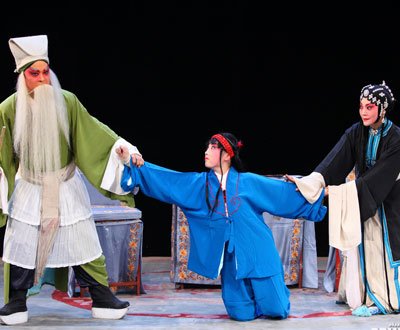

Qinqiang

Cantonese Opera
秦腔 Qinqiang (qín qiāng )
Carried out in the Shaanxi dialect in high-pitched voices, the operatic form has established a venerable tradition as a "shouted out opera" with its bold, resounding arias.
This distinctive opera more closely resembles local yodeling than traditional Chinese opera. It traces its roots to ancient local folk songs and dance forms from the Yellow River Valley of Shaanxi and Gansu provinces -- the birthplaces of Chinese culture. The opera "first appeared in the Qin Dynasty some 2200 years ago before it flourished in the imperial capital of the Tang dynasty Chang'an, which is today's Xi'an. With its long history, Qinqiang is credited as "the forefather of Chinese operas."
Today, Qinqiang has evolved into an established theatre style, but retains its bold and rustic aspect. The pitch is extremely high and the aria timbre is loud and sonorous, keeping in line with the forthright, valiant and industrious character of the local people.
The melodies of this genre are embodied with rich emotions. The operas are straightforward and passionate, with exaggerated and dramatic facial expressions, but also feature delicate emotions that can move audiences. At the moment, Qinqiang opera is not very popular among young people because it is an old kind of opera.
Qinqiang performances are characterized by a simple and bold style that is at once penetratingly exquisite, yet also exaggerated. The roles are categorized into 13 types, namely, four types of shengs, the male roles in traditional Chinese opera, six dan, or female characters, two jing, painted-face characters and one chou, or clown.
粤剧 Cantonese Opera (yuè jù)
Cantonese opera is one of the major categories of Chinese opera, combining Mandarin operatic traditions and the Cantonese dialect. Taking root in the Cantonese-speaking Guangdong and Guangxi areas in southern China, this theatrical form has enjoyed great popularity throughout China, and provides a cultural bond among Cantonese speakers in the country and abroad.
The vocal music in Cantonese opera originated mainly from 'bangzi' and 'erhuang'. It also utilizes a number of songs from Kunqu opera and the regional tunes of Guangdong province, like the Nanyin Music and muyu. The music of Cantonese Opera consists of innumerable melodies and tunes. Chen Shaomei is a veteran performer and choreographer of Cantonese opera for more than 50 years.
Xiaoqu is the sizhu tradition native to the Pearl River delta area centered in Guangzhou. And the paizi tunes have a more archaic flavor compared to other tunes in Cantonese opera. They are unique for their unusual texture produced by the extraordinarily loud and brilliant sound of the suona instruments, gongs and cymbals.
Copyright ©1999-2018
Chinanews.com. All rights reserved.
Reproduction in whole or in part without permission is prohibited.